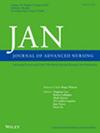Exploring Mechanisms and Contextual Factors for the Normalised Implementation of Transitional Care for Adult Patients With Enterostomy: A Realist Review.
IF 3.4
3区 医学
Q1 NURSING
引用次数: 0
Abstract
AIM To explore how, why and under what circumstances transitional care can be normalised as a routine care practice for adult patients with enterostomy after discharge from hospitals. DESIGN Realist review. METHODS This review was conducted in three iterative phases: (1) constructing an initial programme theory to identify the scope of the study; (2) retrieving and evaluating the evidence, extracting data and integrating the evidence; and (3) analysing and integrating the evidence to refine the programme theory. DATA SOURCES Five bibliographic databases and the grey literature were searched from 1947 to 2024 to identify the studies of two core concepts: enterostomy and transitional care. RESULTS A total of 36 papers were included, identifying nine context-mechanism-outcome configurations that explain how, why and under what circumstances transitional care can be normalised as routine care for adult patients with enterostomy after discharge: (1) Responsibilities of individual roles; (2) Interdisciplinary team collaboration; (3) Support from upper management; (4) Communication and interaction; (5) Multiple linkage; (6) Professional training; (7) External support and policy formulation; (8) Personalised measures; and (9) Evaluation and feedback. CONCLUSION The normalised implementation of transitional care is essential to help enterostomal patients better adapt to stoma life and improve their quality of life. An effective transitional care model not only relies on the support of professional caregivers, but requires the close cooperation of patients, family members, communities and healthcare organisations. REPORTING METHOD Reporting was adhered to the RAMESES publication standards: realist syntheses. PATIENT OR PUBLIC CONTRIBUTION Patients and members of the public were involved in study design. Their contributions were participating in advisory groups, ensuring the research was addressed. IMPACT This study provides theoretical guidance for clinical stoma transitional care, translating the research findings into routine healthcare practices, constantly optimising and improving the stoma care system, and offering patients higher-quality and more efficient services. IMPACT STATEMENT This research, through the realist review approach in combination with the Normalisation Process Theory (NPT) and the Consolidated Framework for Implementation Research (CFIR), systematically elucidates for the first time how, why and under what circumstances transitional care can be regularised as a routine post-discharge care measure for adult enterostomy patients. The research findings will: Improve the quality of life of patients: Through personalised care plans and multidisciplinary team cooperation, help patients better adapt to life with an ostomy, reduce complications and improve self-management ability. Optimise clinical practice: Provide theoretical guidance for medical staff, promote the regular implementation of transitional care and improve the quality and efficiency of care. Promote education and training: Emphasise the importance of professional training and communication skills, and provide new ideas for nursing education. Support policy formulation: Call on the government and medical institutions to improve relevant policies, provide more resources and support and promote the rational allocation of medical resources.探索成年肠造口患者过渡护理规范化实施的机制和背景因素:现实主义回顾。
目的探讨如何、为什么以及在什么情况下,过渡性护理可以成为成年肠造口患者出院后的常规护理做法。DESIGNRealist审查。方法本综述分三个迭代阶段进行:(1)构建初步规划理论以确定研究范围;(2)检索、评价证据,提取数据,整合证据;(3)分析和整合证据,完善程序理论。数据来源从1947年到2024年,我们检索了5个书目数据库和灰色文献,以确定两个核心概念的研究:肠造口术和过渡性护理。结果共纳入36篇论文,确定了9种情境-机制-结果配置,解释了成年肠造口患者出院后过渡性护理如何、为什么以及在什么情况下可以常态化为常规护理:(1)个体角色的责任;(2)跨学科团队协作;(3)上级管理的支持;(4)沟通互动;(5)多重联动;(6)专业培训;(7)外部支持和政策制定;(8)个性化措施;(9)评价与反馈。结论规范化实施过渡性护理,有助于肠造口患者更好地适应造口生活,提高生存质量。有效的过渡护理模式不仅需要专业护理人员的支持,还需要患者、家庭成员、社区和医疗机构的密切合作。报告方法报告遵循RAMESES出版标准:现实主义综合。患者或公众贡献患者和公众成员参与了研究设计。他们的贡献是参加咨询小组,确保研究得到处理。本研究为临床造口过渡护理提供理论指导,将研究成果转化为日常医疗实践,不断优化和完善造口护理体系,为患者提供更高质量、更高效的服务。影响声明本研究通过现实主义回顾方法,结合正常化过程理论(NPT)和实施研究综合框架(CFIR),首次系统地阐明了如何、为什么以及在什么情况下,过渡性护理可以作为成人肠造口患者的常规出院后护理措施。研究成果将:提高患者的生活质量:通过个性化护理计划和多学科团队合作,帮助患者更好地适应造口生活,减少并发症,提高自我管理能力。优化临床实践:为医护人员提供理论指导,推动过渡护理的常态化实施,提高护理质量和效率。促进教育培训:强调专业培训和沟通技巧的重要性,为护理教育提供新思路。支持政策制定:呼吁政府和医疗机构完善相关政策,提供更多的资源和支持,促进医疗资源的合理配置。
本文章由计算机程序翻译,如有差异,请以英文原文为准。
求助全文
约1分钟内获得全文
求助全文
来源期刊
CiteScore
6.40
自引率
7.90%
发文量
369
审稿时长
3 months
期刊介绍:
The Journal of Advanced Nursing (JAN) contributes to the advancement of evidence-based nursing, midwifery and healthcare by disseminating high quality research and scholarship of contemporary relevance and with potential to advance knowledge for practice, education, management or policy.
All JAN papers are required to have a sound scientific, evidential, theoretical or philosophical base and to be critical, questioning and scholarly in approach. As an international journal, JAN promotes diversity of research and scholarship in terms of culture, paradigm and healthcare context. For JAN’s worldwide readership, authors are expected to make clear the wider international relevance of their work and to demonstrate sensitivity to cultural considerations and differences.

 求助内容:
求助内容: 应助结果提醒方式:
应助结果提醒方式:


